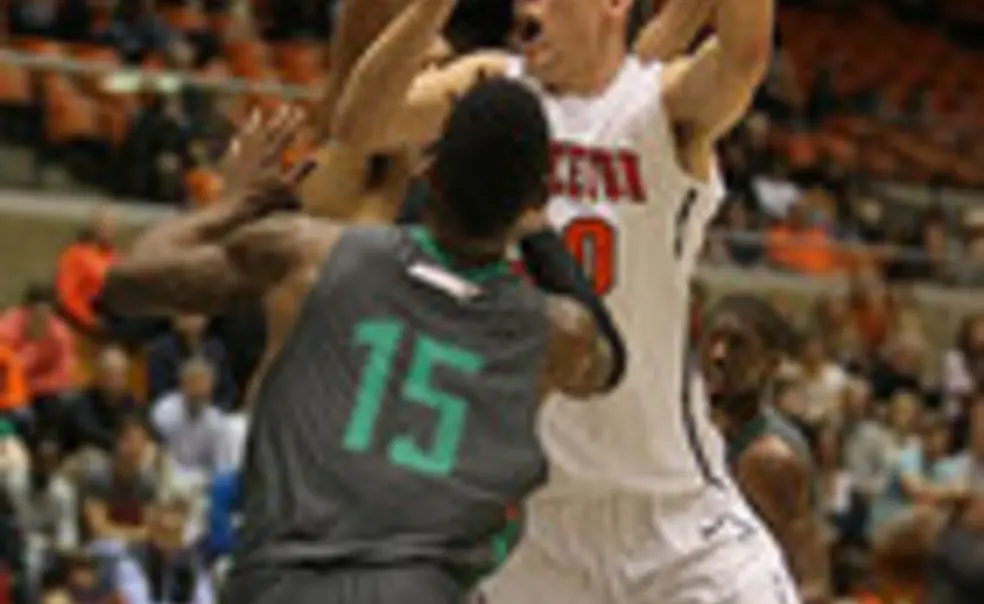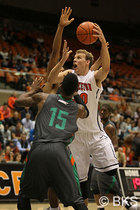Men's Basketball Hangs With Harvard, Falls 82-76
Cambridge, Mass. — Way back in October, before the men’s basketball season had even started, one game at Harvard’s Lavietes Pavilion was already sold out: Harvard vs. Princeton. At the time, the Tigers were not expected to be the Crimson’s top challenger, but after seven thrilling battles with title implications over the past three years, the two sides had developed a history that heightened every showdown. Friday’s game once again proved that Harvard, the Ancient Eight’s nouveau riche, and the old-money Tigers have the Ivy League’s dominant rivalry right now.
Hans Brase '16, shown in an early nonconference game against Florida A&M. (Photo: Beverly Schaefer)
Even before the opening tip, Harvard’s gym was the loudest it had been all season, as its student section was overflowing with support for the Crimson and jeers for the Tigers. In recent years, the Harvard-Princeton rivalry has bloomed because of its two-sided nature — and the fact that the home fans usually have reason to cheer. Princeton has famously won 24 straight meetings at Jadwin Gym, but after holding off the Tigers 82-76 on Friday night, the Crimson now has its own four-game win streak over Princeton at Lavietes Pavilion.
“Princeton-Harvard atmospheres are different than any other atmosphere in the Ivy League,” guard T.J. Bray ’14 said. “It’s been great coming up here for four years. We would’ve liked to get a win, but it’s always been sold out, it’s always been a great atmosphere up here, and we do the same at our place.”
This year’s game showed uncanny parallels to a Princeton-Harvard meeting late in the 2011 season, the first big-time matchup at Lavietes Pavilion. In that game, Dan Mavraides ’11 scored 18 first-half points in a shootout that the Crimson led 37-36 at halftime; on Friday, Hans Brase ’16 had 17 points as Harvard led 36-35 at the break.
As a center shooting 38 percent from three-point range, Brase is a tough matchup for most opponents — especially Harvard’s big men, who prefer to lurk near the rim and block shots. The sophomore lost his defender for three wide-open treys in the first six minutes, and he used his agility to score at the rim on drives or backdoor cuts. “We kind of thought they were going to sag off me a little bit, so I was working on getting a lot of shots up the last few days,” Brase said.
But just as it did in 2011, Harvard pulled away early in the second half. Princeton missed four three-pointers during an 8-0 Harvard run that broke a 42-42 tie; midway through the period, a Kyle Casey dunk stretched the Crimson’s lead to 15 points.
Harvard led by 11 at the three-minute mark, but the Crimson missed several late free throws, opening the door for Bray to make things interesting. The 6’5” senior — who is, per Ken Pomeroy’s advanced statistics, the nation’s eighth-most efficient offensive player — alternated drives and outside shots until a three-pointer made the score 75-71. The Tigers almost stole the ensuing inbounds pass, but Harvard retained possession, and the visitors never got closer.
Princeton proved it could play with the Ivy League’s top team on the road, and if not for poor ball control (16 turnovers) and free-throw shooting (10-for-20), it might have won. As it stands, though, the Tigers are 0-2 in the Ivy League, bringing flashbacks to another recent season: 2012. In the first season of head coach Mitch Henderson ’98, the Tigers lost three early road games and never got back in the middle of the Ivy race.
To stay within reach of Harvard, now alone in first place, Princeton needs to turn its fortunes around quickly. “This is a different team, a different era. The glass is half-full here,” Henderson said. “We’ve got a lot of basketball left.”













No responses yet